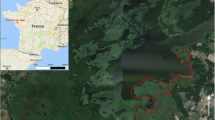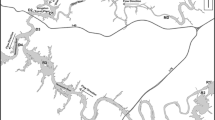Abstract
Food-chain changes in urban and industrial sites may limit breeding-time resources (e.g. food availability) for small insectivorous passerines. We used a long-term data set of pied flycatchers (Ficedula hypoleuca), collected from one of the most polluted sites in Finland during the past 23 years to study the effects of metal pollution on body condition of breeding females. Our results show that body mass started to decline already some days before hatching, indicating a preparation of females to forthcoming chick feeding period. We did not find long-term temporal trends in female body condition index (BCI) in spite of considerably reduced metal emissions during the study period. However, females had higher BCI in polluted than in unpolluted areas during the incubation period. For both incubation and nestling periods the body condition was lower for later breeders, though the condition index decreased slightly faster in relation to hatching date in polluted areas, which may be due to more drastic decrease in nutrition rich food abundance. Temperature and clutch size were positively associated with BCI during the incubation period, but not in the nestling period. Overall, our data suggest that environmental pollution modifies important life-history traits, potentially via indirect effects of higher environmental variability and changed phenology in polluted environment.



Similar content being viewed by others
References
Ackerman JT, Overton CT, Casazza ML, Takekawa JY, Eagles-Smith CA, Keister RA, Herzog MP (2012) Does mercury contamination reduce body condition of endangered California clapper rails? Environ Pollut 162(0):439–448
Alatalo RV, Lundberg A, Glynn C (1986) Female pied flycatchers choose territory quality and not male characteristics. Nature 323(6084):152–153
Askenmo C (1982) Clutch size flexibility in the pied flycatcher Ficedula hypoleuca. Ardea 70(2):189–196
Badzinski SS, Flint PL, Gorman KB, Petrie SA (2009) Relationships between hepatic trace element concentrations, reproductive status, and body condition of female greater scaup. Environ Pollut 157(6):1886–1893
Berglund ÅMM, Rainio MJ, Eeva T (2012) Decreased metal accumulation in passerines as a result of reduced emissions. Environ Toxicol Chem 31(6):1317–1323
Berglund ÅMM, Rainio MJ, Eeva T (2015) Temporal trends in metal pollution: using bird excrement as indicator. PLoS One 10(2):e0117071
Biebach H, Friedrich W, Heine G (1986) Interaction of body mass, fat, foraging and stopover period in trans-sahara migrating passerine birds. Oecologia 69(3):370–379
Bókony V, Seress G, Nagy S, Lendvai ÁZ, Liker A (2012) Multiple indices of body condition reveal no negative effect of urbanization in adult house sparrows. Landsc Urban Plan 104(1):75–84
Burger J, Gochfeld M (1988) Effects of lead on growth in young herring gulls (Larus argentatus). J Toxicol Environ Health 25(2):227–236
Busse P, Kania W (1970) Operation Baltic 1961-1967 - working methods. Acta Ornithol (Warsaw) 12:179–208
Combes C (2001) Parasitism. The ecology and evolution of intimate interactions. Chicago: University of Chicago Press. 728 p
Currie D, Valkama J (1998) Limited effects of heavy metal pollution on foraging and breeding success in the curlew (Numenius arquata). Environ Pollut 101(2):253–261
Dauwe T, Janssens E, Eens M (2006) Effects of heavy metal exposure on the condition and health of adult great tits (Parus major). Environ Pollut 140(2):71–78
Eeva T, Lehikoinen E (1995) Egg-shell quality, clutch size and hatching success of the great tit (Parus major) and the pied flycatcher (Ficedula hypoleuca) in an air-pollution gradient. Oecologia 102(3):312–323
Eeva T, Lehikoinen E (1996) Growth and mortality of nestling great tits (Parus major) and pied flycatchers (Ficedula hypoleuca) in a heavy metal pollution gradient. Oecologia 108(4):631–639
Eeva T, Lehikoinen E (2000) Pollution - recovery of breeding success in wild birds. Nature 403(6772):851–852
Eeva T, Lehikoinen E (2004) Rich calcium availability diminishes heavy metal toxicity in pied flycatcher. Funct Ecol 18(4):548–553
Eeva T, Lehikoinen E (2013) Density effect on great tit (Parus major) clutch size intensifies in a polluted environment. Oecologia 173(4):1661–1668
Eeva T, Lehikoinen E (2015) Long-term recovery of clutch size and egg shell quality of the pied flycatcher (Ficedula hypoleuca) in a metal polluted area. Environ Pollut 201(0):26–33.
Eeva T, Lehikoinen E, Pohjalainen T (1997a) Pollution-related variation in food supply and breeding success in two hole-nesting passerines. Ecology 78(4):1120–1131
Eeva T, Lehikoinen E, Sunell C (1997b) The quality of pied flycatcher (Ficedula hypoleuca) and great tit (Parus major) females in an air pollution gradient. Ann Zool Fenn 34(1):61–71
Eeva T, Lehikoinen E, Rönkä M (1998) Air pollution fades the plumage of the great tit. Funct Ecol 12(4):607–612
Eeva T, Lehikoinen E, Nikinmaa M (2003) Pollution-induced nutritional stress in birds: an experimental study of direct and indirect effects. Ecol Appl 13(5):1242–1249
Eeva T, Ryömä M, Riihimäki J (2005) Pollution-related changes in diets of two insectivorous passerines. Oecologia 145(4):629–639
Eeva T, Ahola M, Lehikoinen E (2009) Breeding performance of blue tits (Cyanistes caeruleus) and great tits (Parus major) in a heavy metal polluted area. Environ Pollut 157(11):3126
Eeva T, Rainio M, Berglund Å, Stauffer J, Stöwe M, Ruuskanen S (2014) Experimental manipulation of dietary lead levels in great tit nestlings – limited effects on growth, physiology and survival. Ecotoxicology 23:914–928
Ekman JB, Hake MK (1990) Monitoring starvation risk: adjustments of body reserves in greenfinches (Carduelis chloris L.) during periods of unpredictable foraging success. Behav Ecol 1(1):62–67
Freed LA (1981) Loss of mass in breeding wrens: stress or adaptation? Ecology 62(5):1179–1186
Haywood S, Perrins CM (1992) Is clutch size in birds affected by environmental conditions during growth. Proc R Soc B-Biol Sci 249(1325):195–197
Hill GE (1990) Female house finches prefer colourful males: sexual selection for a condition dependent trait. Anim Behav 40(3):563–572
Jakob EM, Marshall SD, Uetz GW (1996) Estimating fitness: a comparison of body condition indices. Oikos 77(1):61–67
Janssens E, Dauwe T, Pinxten R, Bervoets L, Blust R, Eens M (2003) Effects of heavy metal exposure on the condition and health of nestlings of the great tit (Parus major), a small songbird species. Environ Pollut 126(2):267–274
Kiikkilä O (2003) Heavy-metal pollution and remediation of forest soil around the Harjavalta cu-Ni smelter, in SW Finland. Silva Fennica 37(3):399
Koivula MJ, Kanerva M, Salminen JP, Nikinmaa M, Eeva T (2011) Metal pollution indirectly increases oxidative stress in great tit (Parus major) nestlings. Environ Res 111(3):362–370
Kozlov MV, Eränen JK, Zverev VE (2007) Budburst phenology of white birch in industrially polluted areas. Environ Pollut 148:125–131
Kozlov MV, Zvereva EL, Zverev VE (2009) Impacts of point polluters on terrestrial biota: comparative analysis of 18 contaminated areas introduction. Springer, Netherland, p 466
Kubin E, Lippo H, Poikolainen J (2000) Heavy metal loading. In: Mälkönen E, eds. Forest condition in a changing environment- the Finnish case. Kluwer Academic Publishers: Kluwer Academic Publishers. p 60–71
Kullberg C, Metcalfe NB, Houston DC (2002) Impaired flight ability during incubation in the pied flycatcher. J Avian Biol 33(2):179–183
Labocha MK, Hayes JP (2012) Morphometric indices of body condition in birds: a review. J Ornithol 153(1):1–22
Laet JFD, Dhondt AA (1989) Weight loss of the female during the first brood as a factor influencing second brood initiation in great tits Parus major and blue tits P. caeruleus. Ibis 131(2):281–289
Lambrechts MM, Adriaensen F, Ardia DR, Artemyev AV, Atienzar F, Banbura J, Barba E, Bouvier J-C, Camprodon J, Cooper CB, Dawson RD, Eens M, Eeva T, Faivre B, Garamszegi LZ, Goodenough AE, Gosler AG, Gregoire A, Griffith SC, Gustafsson L, Johnson LS, Kania W, Keiss O, Llambias PE, Mainwaring MC, Mand R, Massa B, Mazgajski TD, Møller AP, Moreno J, Naef-Daenzer B, Nilsson J-Å, Norte AC, Orell M, Otter KA, Park CR, Perrins CM, Pinowski J, Porkert J, Potti J, Remes V, Richner H, Rytkonen S, Shiao M-T, Silverin B, Slagsvold T, Smith HG, Sorace A, Stenning MJ, Stewart I, Thompson CF, Tryjanowski P, Torok J, van Noordwijk AJ, Winkler DW, Ziane N (2010) The design of artificial nestboxes for the study of secondary hole-nesting birds: a review of methodological inconsistencies and potential biases. Acta Ornithol 45(1):1–26
Lifjeld JT, Slagsvold T (1986) The function of courtship feeding during incubation in the pied flycatcher Ficedula hypoleuca. Anim Behav 34:1441–1453
Loman J (1984) Breeding success in relation to parent size and experience in a population of the hooded crow. Ornis Scand 15(3):183–187
Lundberg A, Alatalo RV (1992) The pied flycatcher. T & AD Poyser, London, 267 p
Lyon BE, Montgomerie RD (1985) Incubation feeding in snow buntings: female manipulation or indirect male parental care. Behav Ecol Sociobiol 17(3):279–284
Moreno J (1989) Strategies of mass change in breeding birds. Biol J Linn Soc 37(4):297–310
Murphy E, Haukioja E (1986) Clutch size in nidicolous birds. Curr Ornithol 4:141–179
Newton I, Marquiss M, Village A (1983) Weights, breeding, and survival in european sparrowhawks. Auk 100(2):344–354
Norberg RÅ (1981) Temporary weight decrease in breeding birds may result in more fledged young. Am Nat 118(6):838–850
Nur N (1984) The consequences of brood size for breeding blue tits. I. Adult survival, weight change and the cost of reproduction. J Anim Ecol 53(2):479–496
Nur N (1988) The cost of reproduction in birds: an examination of the evidence. Ardea 76(2):155–168
Orell M, Koivula K (1988) Cost of reproduction: parental survival and production of recruits in the willow tit Parus montanus. Oecologia 77(3):423–432
Rainio MJ, Kanerva M, Salminen J-P, Nikinmaa M, Eeva T (2013) Oxidative status in nestlings of three small passerine species exposed to metal pollution. Sci Total Environ 454-455(0):466–473
Ricklefs RE (1974) Avian energetics. Publications of Nuttal Ornithological Club, Cambridge
Roff D (2002) Life history evolution: MA: Sinauer. 465 p
SAS (2013) Base SAS 9.4 Procedures Guide: Statistical Procedures. Version SAS 9.4: SAS Institute Inc
Schulte-Hostedde AI, Zinner B, Millar JS, Hickling GJ (2005) Restitution of mass-size residuals: validating body condition indices. Ecology 86(1):155–163
Silverin B (1980) Seasonal development of reproductive organs in the female pied flycatcher Ficedula hypoleuca and experimental studies on duration of her re-nesting ability. J Zool 190:241–257
Silverin B (1981) Reproductive effort, as expressed in body and organ weights, in the pied flycatcher. Ornis Scand 12(2):133–139
Slagsvold T, Johansen MA (1998) Mass loss in female pied flycatchers Ficedula hypoleuca during late incubation: supplementation fails to support the reproductive stress hypothesis. Ardea 86(2):203–211
Svensson L (1992) Identification guide to European passerines. Fingraf AB, Södertälje
Tinbergen JM, Boerlijst MC (1990) Nestling weight and survival in individual great tits (Parus major). J Anim Ecol 59(3):1113–1127
Väisänen R, Lehikoinen A (2013) Monitoring population changes of land bird species breeding in Finland in 1975-2012. Linnut vuosikirja 2012
Wiebe KL, Vitousek MN (2015) Melanin plumage ornaments in both sexes of northern flicker are associated with body condition and predict reproductive output independent of age. Auk 132(2):507–517
Acknowledgements
We are grateful to Esa Lehikoinen, Jorma Nurmi and all the other persons who have been involved in this project over the past 23 years in Harjavalta. We also thank Kalle Rainio and the anonymous referees for the valuable comments on the manuscript. This study was funded by KONE Foundation (SR, MR), the Finnish Cultural Foundation (MR) and Academy of Finland (TE, project number 265859).
Author information
Authors and Affiliations
Corresponding author
Ethics declarations
Conflict of interest
The authors declare that they have no conflict of interest.
Rights and permissions
About this article
Cite this article
Rainio, M.J., Ruuskanen, S. & Eeva, T. Spatio-temporal variation in the body condition of female pied flycatcher (Ficedula hypoleuca) in a polluted environment. Urban Ecosyst 20, 1035–1043 (2017). https://doi.org/10.1007/s11252-017-0657-2
Published:
Issue Date:
DOI: https://doi.org/10.1007/s11252-017-0657-2




